LeCoultre U.S. chronographs are cool, simple as that. But we simply don't know enough about them to truly appreciate their style, desirability and rarity. We can't even make out reference numbers for many of the pieces. This is thus my attempt to catalogue these marvels of 20th Century watchmaking focusing on the Valjoux-powered versions.
March 13, 2024
Valjoux-nited States of LeCoultre: The Mystery & History of the LeCoultre Chronograph - Part I

Marcus Siems @siemswatches
Collector, Author, Data Analyst
Jaeger-LeCoultre introduced their first mechanical wristwatch chronograph (the Reverso Chronographe Retrograde, Cal. 829) in 1996[1]! Let that sink in for a second... The watchmaker's watchmaker launched their first in-house wrist-wornx chronograph the same year the Spice Girls released "Wannabe". That's almost 100 years of wristwatches without a JLC chronograph.
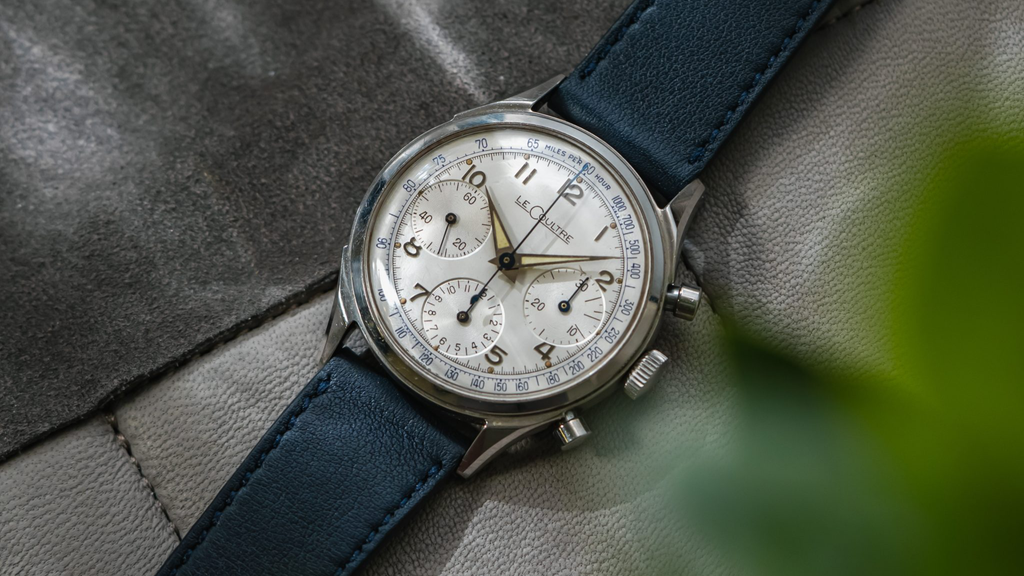 This is a pre-2000 Jaeger-LeCoultre chronograph. It is a Valjoux 72 powered example with a quite sporty look. It is actually hard to date these pieces (and we come to that a little later) but this ref. E335 is a splendid example from probably the 1960s/70s, perfectly showcasing what LeCoultre brought to the U.S. chronograph market. Photo Courtesy of Hairspring Watches.
This is a pre-2000 Jaeger-LeCoultre chronograph. It is a Valjoux 72 powered example with a quite sporty look. It is actually hard to date these pieces (and we come to that a little later) but this ref. E335 is a splendid example from probably the 1960s/70s, perfectly showcasing what LeCoultre brought to the U.S. chronograph market. Photo Courtesy of Hairspring Watches.
However, that doesn't mean there didn't exist chronograph watches with Jaeger LeCoultre signatures on the dial. Well, predominantly they existed with either Jaeger or LeCoultre. For most of the last Century JLC's approach to chronographs watches was quite similar to Cartier: There have been three relatively independent branches of the company producing pieces for different markets. Jaeger-LeCoultre for the Swiss and main European market (whilst majorly quiet), Jaeger was the French connection and LeCoultre was dedicated to the Northern Americans[2-3].
Thus, already the setup for this guide - and more generally the entire history of these pieces - is quite geeky, fascinating and to some extent totally absurd. One of the top movement manufacturers has been neglecting one - if not THE - central complication of the last Century and bringing in external ebauches. And it appears they haven't been too confident in "their" chronographs as prior to the 1980s most of these pieces simply don't bear the full Jaeger-LeCoultre name*.
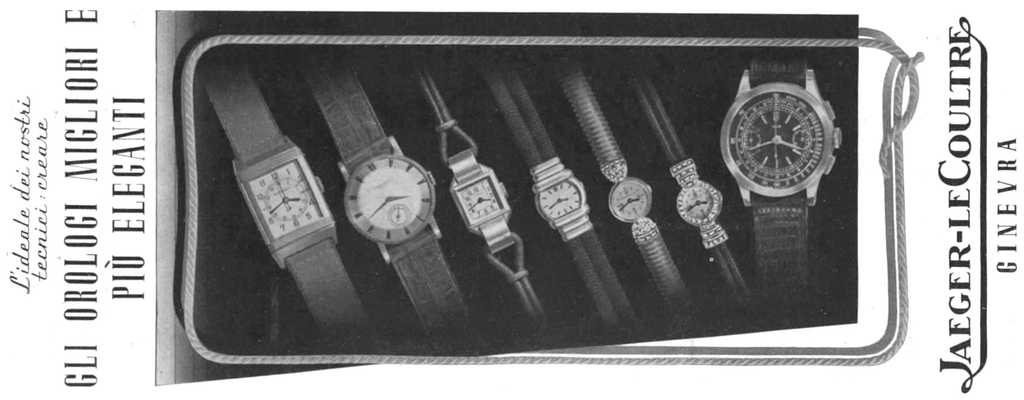 Italian Jaeger-LeCoultre ad from 1941 featuring a "Jaeger" signed chronograph. Ad Courtesy of HIFI Archiv.
Italian Jaeger-LeCoultre ad from 1941 featuring a "Jaeger" signed chronograph. Ad Courtesy of HIFI Archiv.
In principle we got all the ingredients for some classic vintage watch collectibles ... but these pieces are still flying under the radar. One of the main reasons is likely scholarship or rather the lack thereof. It is really tough to understand these pieces and their history let alone defining common denominators to put a price tag on them. And it doesn't help that most of the LeCoultre chronographs didn't even have proper reference numbers.
I thus set out to catalogue the LeCoultre chronographs (1937-85)**, guide you through the cloud of uncertainty surrounding these pieces and find their proper place in (U.S.) history.
1) Two Types of Movements
All the LeCoultre signed chronograph watches featured one of two movement families: Valjoux or Universal Geneve. I will focus on the Valjoux pieces in Part I[5] and leave the Universal Geneve for Part II. Gladly, the two caliber families are well distinguishable even without opening the case-back. Jaeger & LeCoultre made it easy for us and designed very distinct watch cases according to the movement ticking inside:
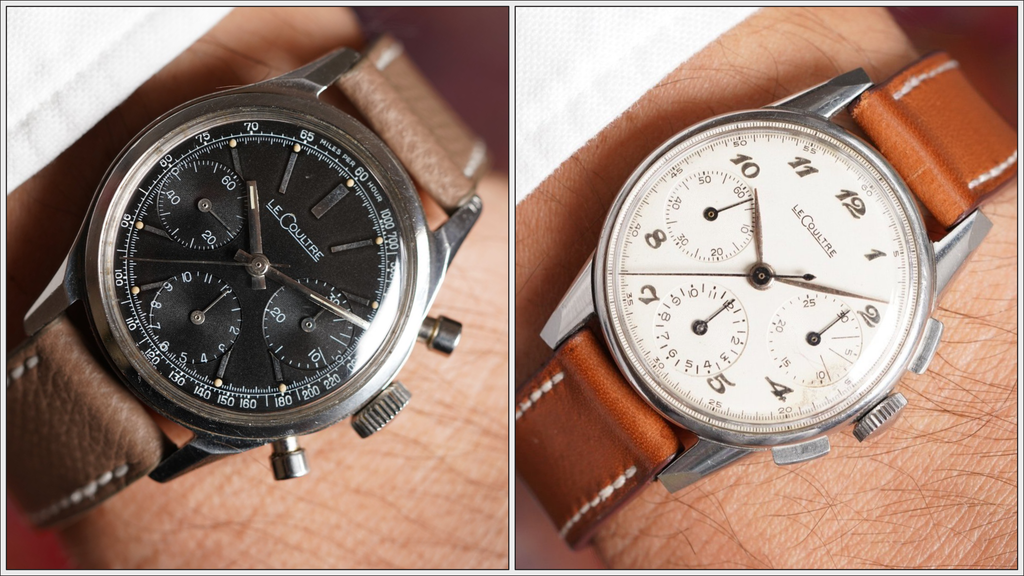 Two LeCoultre chronograph pieces, the left (ref. 2644) with a Valjoux 72 and the right (ref. 224115) with a Martel/UG 285. Photos Courtesy of WindVintage and Strictly Vintage Watches.
Two LeCoultre chronograph pieces, the left (ref. 2644) with a Valjoux 72 and the right (ref. 224115) with a Martel/UG 285. Photos Courtesy of WindVintage and Strictly Vintage Watches.
On the one hand, all pieces with a Valjoux movement come with mushroom chronograph pushers and screw-down case-backs. On the other hand, Universal Geneve (Martel) powered LeCoultre chronographs feature rectangular pushers and a snap-on case-back[8]. Thank you Jaeger-LeCoultre for sticking to this!
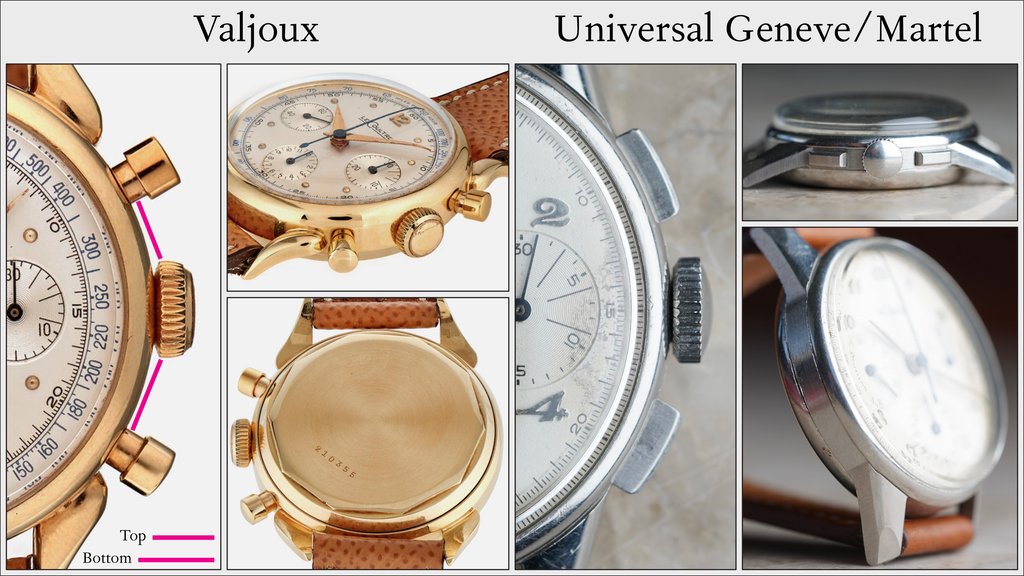 Figure 1. Comparing the distinct features of a Valjoux-(left) and UG/Martel-powered LeCoultre chronograph. UG/Martel come with rectangular pushers and snap-on case-backs. Valjoux examples always feature mushroom pushers and a screw-down case-back. By the way, you can always identify such a Valjoux-based chronograph independent of the manufacturer via the distances of the pushers from the crown: The top pusher is closer to the crown. Photos Courtesy of Hodinkee and Strictly Vintage Watches.
Figure 1. Comparing the distinct features of a Valjoux-(left) and UG/Martel-powered LeCoultre chronograph. UG/Martel come with rectangular pushers and snap-on case-backs. Valjoux examples always feature mushroom pushers and a screw-down case-back. By the way, you can always identify such a Valjoux-based chronograph independent of the manufacturer via the distances of the pushers from the crown: The top pusher is closer to the crown. Photos Courtesy of Hodinkee and Strictly Vintage Watches.
2) Golden LeCoultre Chronographs
Let's start with our catalogue and guide. Calling it a reference guide is a stretch as indeed many of these pieces did not feature a reference number in the classic sense. I thus tried to establish individual "models" through case-shape and lug design.
So we're starting off with the golden examples. Traditionally, Jaeger-LeCoultre has been exporting 14k gold cases to the U.S. or produced the cases locally to save on tariffs[2-3]. However, all three identifiable golden models were actually produced in 18k yellow gold and featured a Swiss hallmark inside the case-back - #170 hammerhead for Charles Dubois & Cie[4]. Thus, no tariff saving strategies have been at play here.
 One example LeCoultre chronograph in 18k gold with a Charles Dubois & Cie (Le Locle, hammerhead #170). Photo Courtesy of Monaco Legend Group.
One example LeCoultre chronograph in 18k gold with a Charles Dubois & Cie (Le Locle, hammerhead #170). Photo Courtesy of Monaco Legend Group.
Cornes de Vache

Case. The Cornes de Vache lug design is one you'd typically associate with Vacheron Constantin. But it is also our first distinguishable chronograph designs. The design also perfectly showcases the relationship between VC and JLC overseas[2-3]. These pieces come in at 35mm.
Dial. There's one dial layout - Arabic 12 and dot markers. They come in classic white/cream or golden colored and a blue tachymeter- or seconds-scale. Further, you'll find these pieces with faceted Dauphine or Alpha hands (luminous Dauphine might be possible as well). The dials are signed "Swiss" at 6o'clock.
Case Serials. I identified examples of this style with case serials over various batches in the 143.xxx-145.xxx; 173.xxx; 204.xxx; & 210.xxx ranges.
Classic Gold
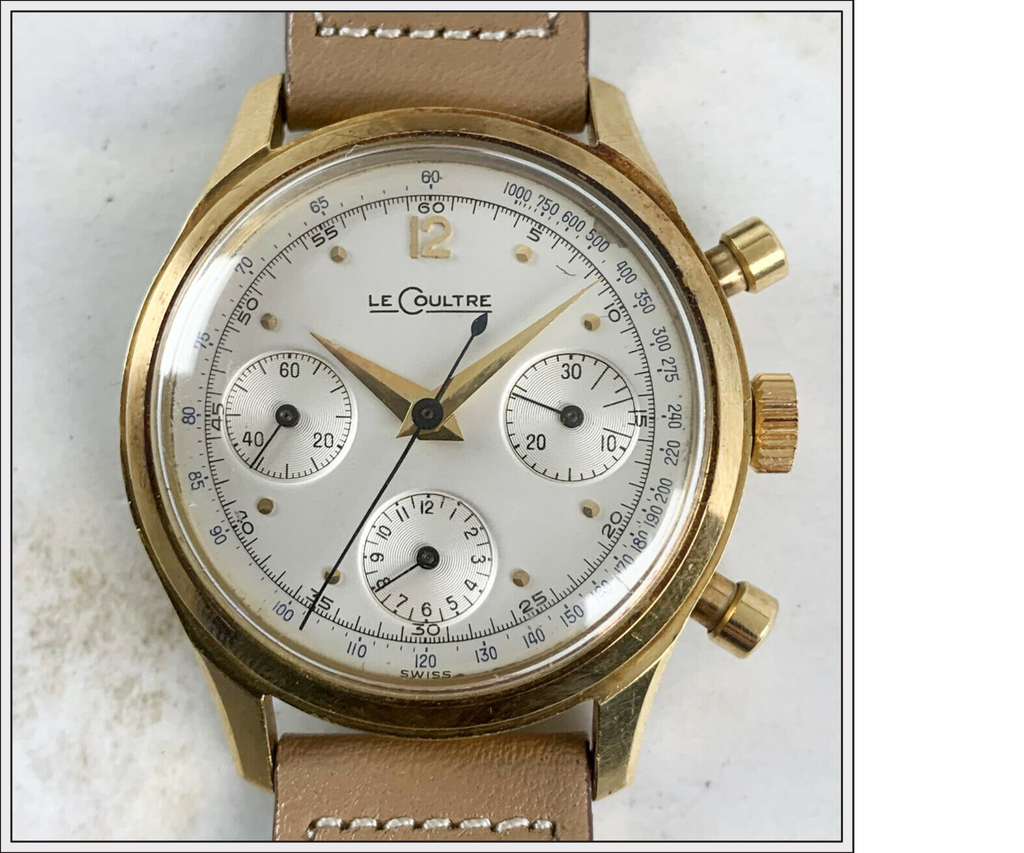
Case. Here, you can find 35.5mm cases with a stepped convex bezel. The lug base extents slightly beyond the case diameter and displays a slim slightly downturned bevel on the outer perimeter over the entire lug length.
Dial. These examples overlap in dial layout and design with the Cornes de Vache models and are equally signed "Swiss" only.
Case Serials. The serial range on these pieces appears to be quite narrow. From four identified examples all were in the 249.6xx range. Production might thus be as low as a couple dozen or hundred examples (speculation).
Sporty Gold

Case. The 36mm case is relatively classic. It comes with the same bezel style as the Classic Gold but without bevelled lugs. As with all gold LeCoultre pieces the lugs are also relatively thin - as seen in the profile - in comparison to the overall case height. This specific model also exists with guilloched cases (see below), and further ads/catalogues suggest some came with textured golden bracelets.
Dial. This is the "Sporty" part. This model comes with a two-tone silver/white dial, golden sub-dial boundaries, fat onyx-filled hour markers (similar to the Rolex Wide Boy markers) and a raised gold LeCoultre signature. These will also come with an Arabic 12 and tachymeter scale, signed "T Swiss T". The lume plots are outside the hour marker as part of the seconds-track.
Case Serials. I identified seven examples all in the 275.28x - 275.3xx range and another 275.6xx. These pieces are extremely rare and production is probably in the low hundreds (speculation).
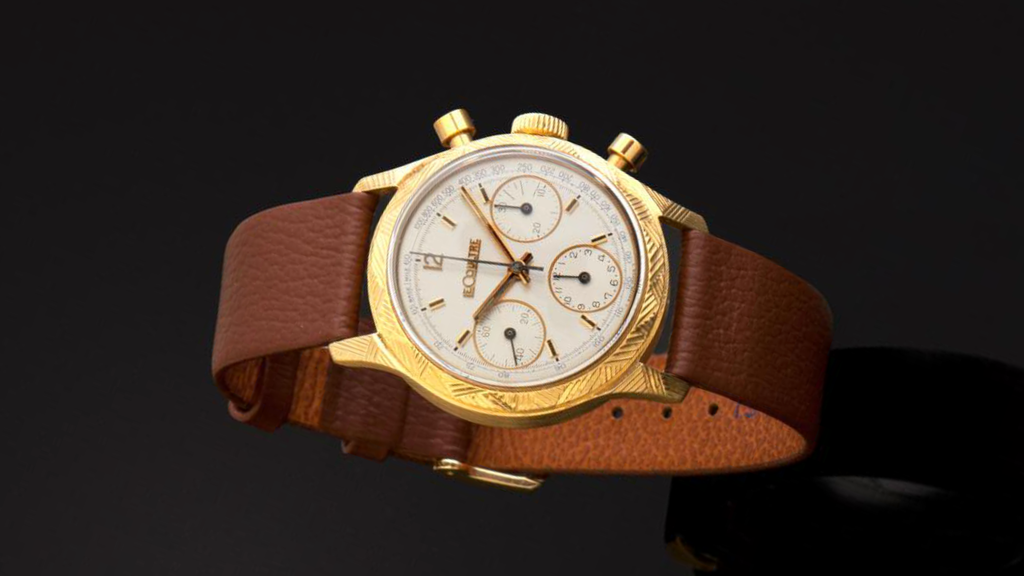 The "Funky Gold" LeCoultre chronograph with guilloched bezel and lugs. Photo Courtesy of Boule Auction.
The "Funky Gold" LeCoultre chronograph with guilloched bezel and lugs. Photo Courtesy of Boule Auction.
If we compare the three models we can see that two have a quite similar case design where only the lug bevelling can distinguish the exterior. And we got the Cornes de Vache (Cow-Horn) lugs, which will always stand out against the rest.
 Figure 2. Comparing the cases on three yellow gold LeCoultre chronograph pieces and their respective lug styles. Sporty Gold (left), Classic Gold (middle), Cornes de Vache (right). Photos Courtesy of Monaco Legend Group, WatchCharts/Ebay & Hodinkee.
Figure 2. Comparing the cases on three yellow gold LeCoultre chronograph pieces and their respective lug styles. Sporty Gold (left), Classic Gold (middle), Cornes de Vache (right). Photos Courtesy of Monaco Legend Group, WatchCharts/Ebay & Hodinkee.
3) The Steel References
There are indeed a couple LeCoultre chronograph models for which you'll find a reference number. These become more standard during the 1970s and can be found inside the case back. But what you'll also see is models that are paired with a reference number based on attribution - for example per catalogue or ad. From the latter it can be hard to reconstruct the source and I will indicate these examples with a +.
 LeCoultre catalogue/price list excerpts from 1973 displaying four stainless steel, one 18k gold and one two-tone (stainless steel & 14k gold bezel) chronographs from the time. Photos Courtesy of Clavi @fldx_clavi.
LeCoultre catalogue/price list excerpts from 1973 displaying four stainless steel, one 18k gold and one two-tone (stainless steel & 14k gold bezel) chronographs from the time. Photos Courtesy of Clavi @fldx_clavi.
Ref. E335 - Master Mariner 12h Chronograph

Case. These specimen come with a 36mm stainless steel case***. The stepped bezel is relatively flat and the lugs are bevelled. The outer bevel is broad at the base and tapers to the rounded tip.
Dial. There are two classic dial type for these pieces both with sunken sub-dials: 1) white/silver dial with full applied Arabic numerals and outer tachymeter in blue. The hands are Dauphine shaped with (mostly) slim lume. 2) black dial, no numerals, stick markers and straight hands with slim lume. The minute hand appears visually very long. For both variations the lume plots are inside the tachymeter as part of the second-scale. They were signed "T Swiss T" at 6o'clock.
Case Serials. Over nine different pieces I could identify three distinct case number batches - in the 211.6xx (one example, 1958), 282.3xx (two pieces) and the 301.1xx - 301.2xx range. Again, highlighting the potential rarity of these pieces somewhere in the low hundreds (speculation).
Ref. E2644
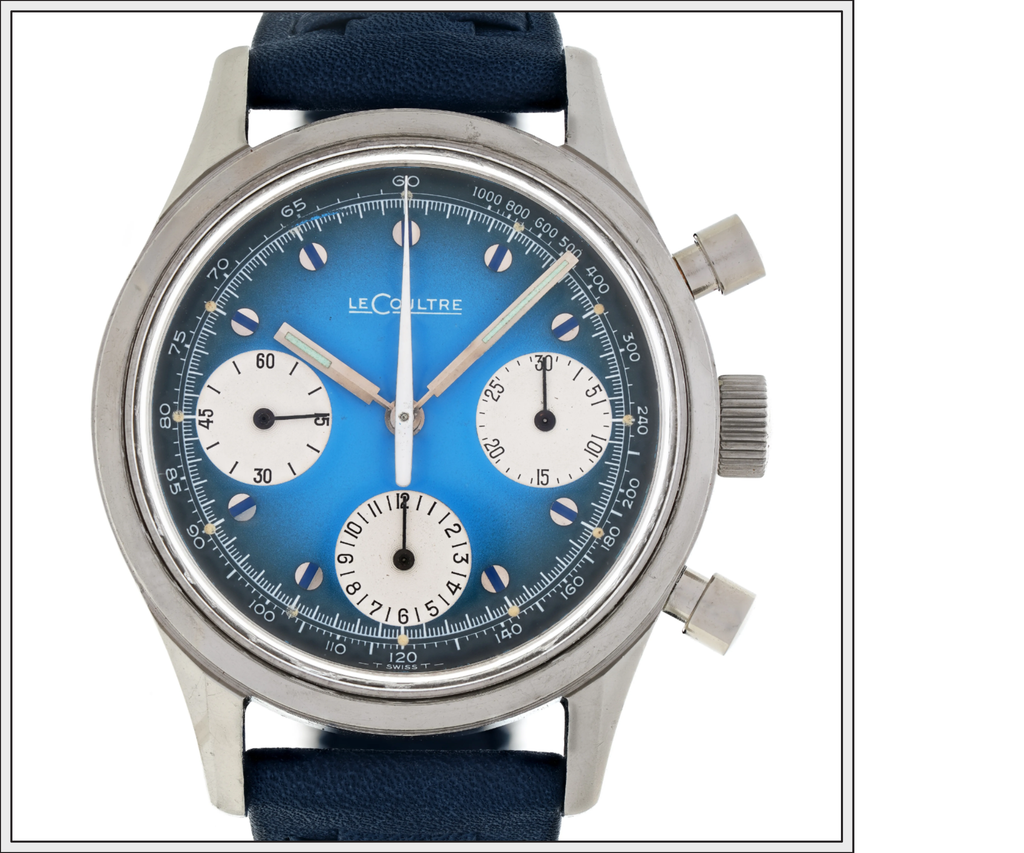
Case. The cases of the E2644 are (afaik) indistinguishable from the E335 and might thus be described as the successor reference. On the individual watch level it is actually hard to make the point that the E2644 with black dial is a different model as the E335 as also the case number ranges overlap (see below). However, there are iteration with a blue fume dial, which are clearly stamped "E2644" inside the caseback. The outer triangular bevel on these fume E2644 might be slimmer and lugs more elongated but one would need to directly compare two alongside each other.
Dial. There are two documented dial types: A monochromatic black dial version, the same as the E335. A second version is the aforementioned blue-to-black fume/fog/vignette dial (made by Singer). The center is blue and the surround from the scales onward is black. The markers are round steel with blue stripe inserts center-facing, and the hands are "paddle" shaped with slim lume. [Caution] A third iteration is a red dial with red accents, which looks much like a Space Compax layout - those are presumably Franken pieces(!).
Case Serials. Generally, signed E2644 don't display case numbers whereas the documented black dial versions come in the range of 287.xxx, 300.4xx and 301.2xx (three examples).
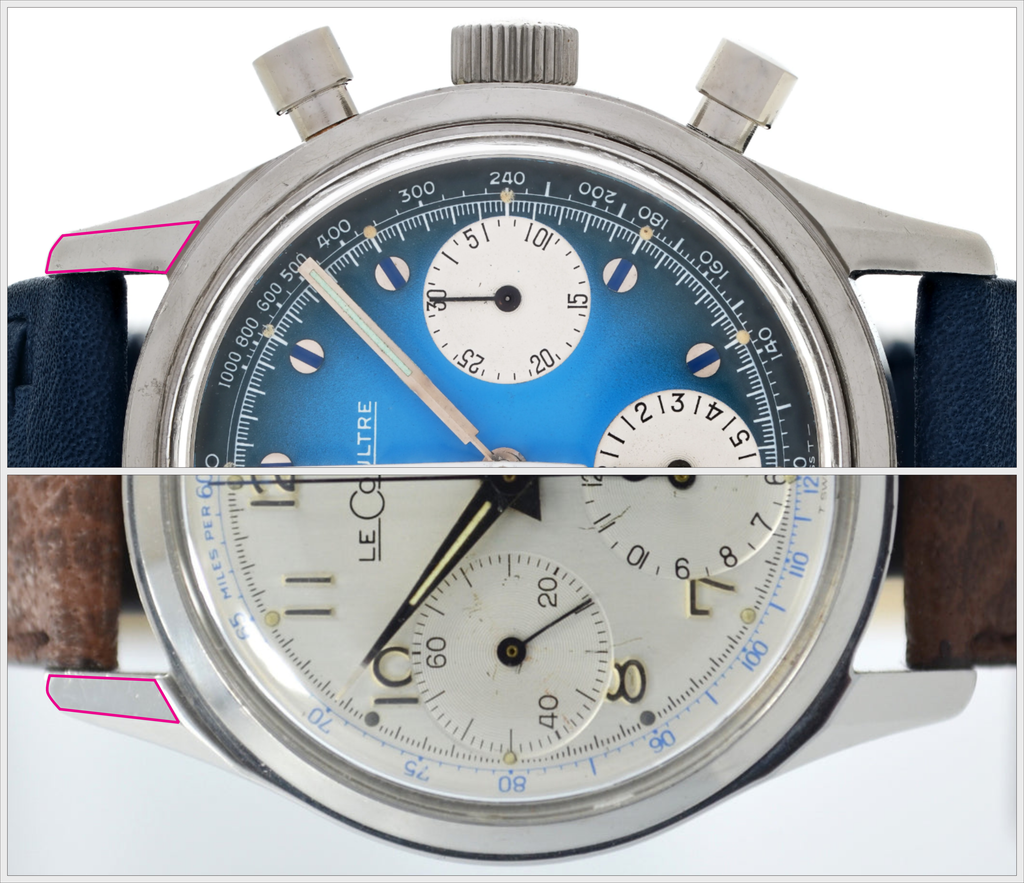 Figure 3. Direct comparison between the E2644 (top) and E335 (bottom) case design. The top lug bevel appears longer and slimmer on the E2644, also the outer bevel might be curved on those but it is hard to say if it is a matter of perspective. Photos Courtesy of Grailium and HashTag Watch Co.
Figure 3. Direct comparison between the E2644 (top) and E335 (bottom) case design. The top lug bevel appears longer and slimmer on the E2644, also the outer bevel might be curved on those but it is hard to say if it is a matter of perspective. Photos Courtesy of Grailium and HashTag Watch Co.
Ref. E355+
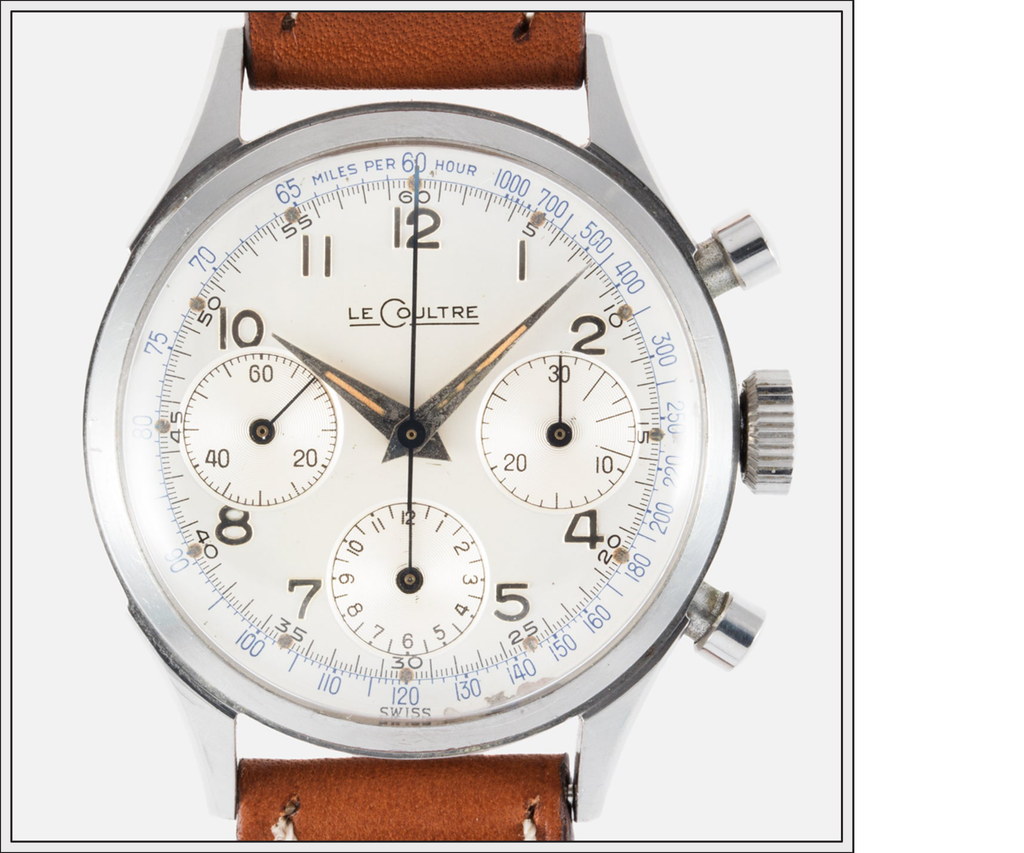
Case. Reference E355 cases are quite unique due to one feature - "attached" lugs. If you look closely you can see how the outer edge of the lug forms a crownguard towards the chrono pushers. The faceted lugs have a slimmer outer bevel compared to the E335 for example, the tip is also angled and not round. It measures 35.5mm.
Dial. The dial comes predominantly in white with full raised numeral layout. It is generally compatible to the E335 in white. The hands are Dauphine with either slim (signed "Swiss" only) or full lume filling (signed "T Swiss T").
Case Serials. The E355 case numbers come over several ranges and might display this model to be one the more common ones. Based on 14 examples it comes in the 142.5xx, 143.0xx, 156.8xx-157.0xx, 173.8xx, 204.3xx, 249.4xx-249.6xx, 262,4xx & 271.xxx
Ref. E2643 - "Shark"
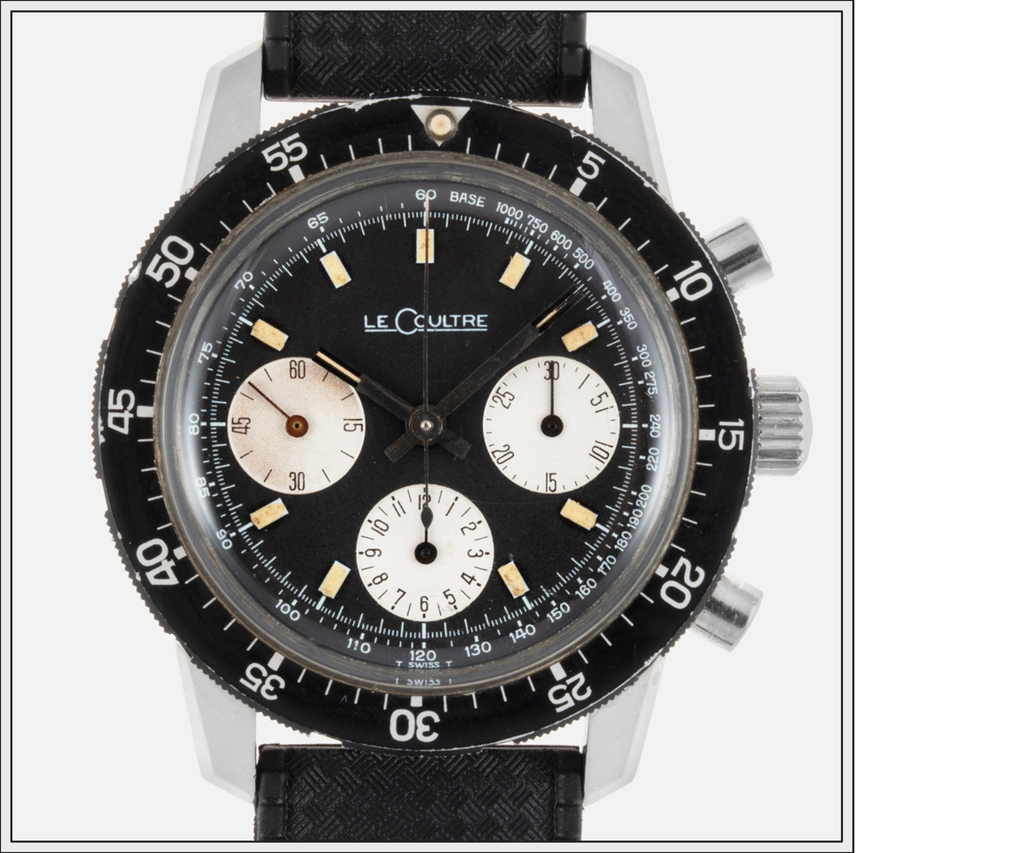
Case. The "Shark" DeepSea (called "Vogue" in Europe) is a dive watch chronograph introduced at latest during the late 1960s. It comes in a large 40mm case with various functional bezel options that include count-up, count-down and world-timer. The lugs display sharp bevels around the outer rim.
Dial. The dial is a Reverse Panda (black with white sub-dials) and large rectangular luminous markers ("T Swiss T"). You can also find a tachymeter in white gracing the outer dial perimeter. It comes with stripe hands, the tip is lume filled and colored in black.
Case Serials. The E2643 - just like the fume E2644 - does not display case numbers.
Ref. E2645 - "Chronograph 200"

Case. Think Space Age design paired with 1990s music and here we are with the E2645. It's a 37mm tonneau case chronograph in steel with a 14k gold bezel and hidden lugs.
Dial. The dial has several similarities with the Sporty Gold examples (same period). It got a raised LeCoultre signature on a silver brushed dial with golden faceted markers. It comes with golden index hands with lume filled tips and a bright red chrono hand. The dial is signed "T Swiss T".
Case Serials. The E2645 does not display case numbers.
Ref. E2646 - Sportster

Case. The 2646 case is the same as the tonneau E2645 but comes with an orange tachymeter bezel (base 500).
Dial. The dial is black with orange sub-dials and applied LeCoultre signature. The hands are broad and faceted Dauphines with a luminous inclusion towards the tip.
Case Serials. The E2646 does not display case numbers but is not often found on the market (I dug up two instances).
Ref. E2647 - Calculator

Case. The E2647 case is in overall shape compatible with the 2645/2646 but relatively oversized at 38.5mm. It is further equipped with a slide-rule bezel.
Dial. The slate grey dial features large steel marker with black center-facing accents, the hands display the same overall design. The markers are framed by a white rim and a seconds track including lume plots. The dial features an applied JLC logo and painted LeCoultre signature. The white sub-dials are small in proportion leaving negative space on the dial. The chrono-second hand comes in red with an outer lume-filled rectangular compartment ("T Swiss T").
Case Serials. The E2647 does not display case numbers.
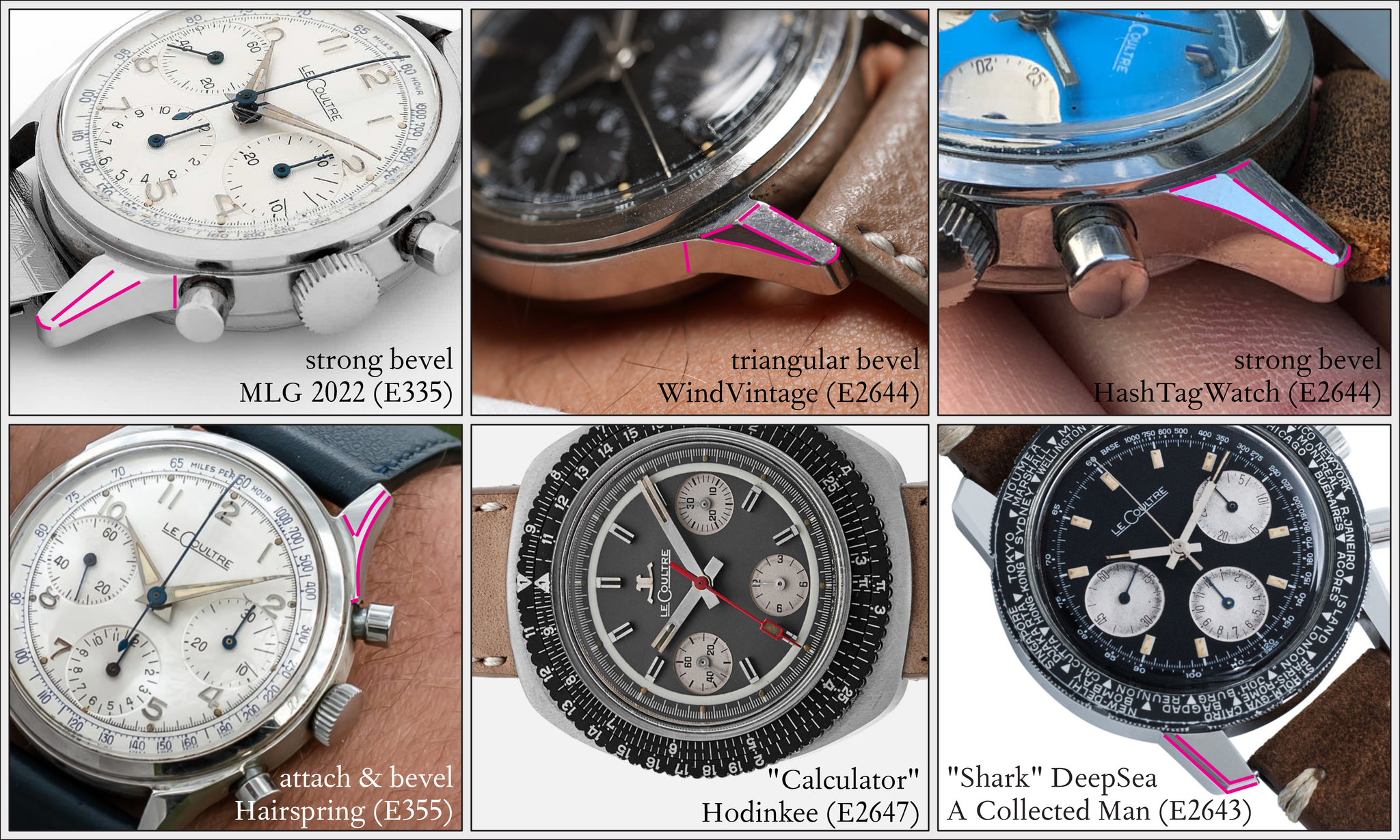 Figure 4. Overview over several steel LeCoultre chronograph variants. Distinctive case and lug features are highlighted in pink. Photos Courtesy of Monaco Legend Group, WindVintage, Hashtag Watch Co., Hairspring Watches, Hodinkee & A Collected Man.
Figure 4. Overview over several steel LeCoultre chronograph variants. Distinctive case and lug features are highlighted in pink. Photos Courtesy of Monaco Legend Group, WindVintage, Hashtag Watch Co., Hairspring Watches, Hodinkee & A Collected Man.
The not-so-well documented bunch
You can find a couple other examples over several auctions... many of which also come with some red flags at times. It is further hard to find common grounds on originality when the sample size of these timepieces is one or close to one. Thus, if you want to learn more about them you'd have to find examples and get some hands-on knowledge first (unfortunately).
So without further ado... We got a "Slim Bezel with Extend Bevel Lug" design (serial 128.2xx, 37mm), a "Stepped Bezel with Extend Bevel Lug" (37mm), and a "Oyster-Esque" design (35mm) and the aforementioned highly debated and likely fabricated "Space-Compax" E2644.
5) Caveats of the Lecoultre Chronographs
Last but not least there are certain characteristics that are common between all original LeCoultre chronograph pieces of the last Century. If you're on the hunt for one of these pieces you might want to look out for:
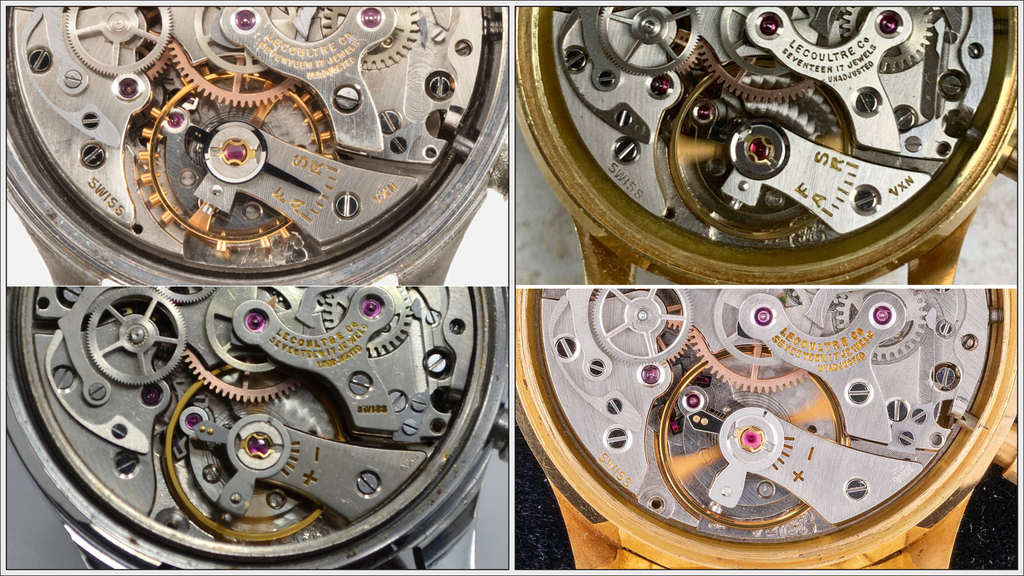 Figure 5. "VXN" signed Valjoux 72 movements. The signature should typically occur on the balance wheel bridge. Photos Courtesy of Monaco Legend Group, S. Song Watches, HashTag Watch Co., & WatchCharts/Ebay.
Figure 5. "VXN" signed Valjoux 72 movements. The signature should typically occur on the balance wheel bridge. Photos Courtesy of Monaco Legend Group, S. Song Watches, HashTag Watch Co., & WatchCharts/Ebay.
- As the watches and hence movements were designated for the U.S. market most of them should come with the "VXN" (rarely "LEC") stamp on the balance wheel bridge - indicating export for the Vacheron & Constantin and LeCoultre distribution.
- Further, LeCoultre only used Valjoux 72 movements for their chronographs. There do not exist any Valjoux 23 (2-register) or calendar chronograph LeCoultre watches[6]!
- "There are no Valjoux 23, and also no calendar chronos in US LeCoultre. Ever. [...] Only V72. [...] But you can get the V23 on some Jaeger ones". - Clavi @fldx_clavi -
6) Conclusion & Collectibility Statement
All in all, we can count at least 10 distinct models and references in the realm of vintage LeCoultre chronographs specially designated for the North American market. Each one of them with one of the most exciting chronograph calibers of the last Century. Ten models is arguably not a lot of distinguishable designs but we still got something for everyone:
 It arguably doesn't get much better when you're looking for a dressy chronograph with a very recognizable design. Photo Courtesy of WindVintage.
It arguably doesn't get much better when you're looking for a dressy chronograph with a very recognizable design. Photo Courtesy of WindVintage.
The classic elegance. If you are looking for a classy and dressy chronograph you got two extremely desirable options (imho). The Cornes de Vache chronograph is one of the most iconic looks in the genre and the LeCoultre iteration does indeed come at a fraction of the price you'd have to pay for a VC example. Vacheron made only about 36 pieces of their famous ref. 6087[7] - a watch that too was based on a Valjoux ebauche (VZ23) and several of them were exported to the American market (VXN movement marks). Quite frankly, the LeCoultre Cornes de Vache probably won't be much more common than the VC 6087 and in terms of desirability it boils down whether you prefer the negative space from the missing 12h counter at 6o'clock or not.
The other very classic example is the Classic Gold. To stay with the comparison to the Holy Trinity evergreens this is a great option to a VC ref. 4072. It's a restrained chronograph, so classic, so vintage. All in all, a perfectly proportionate dress chronograph.
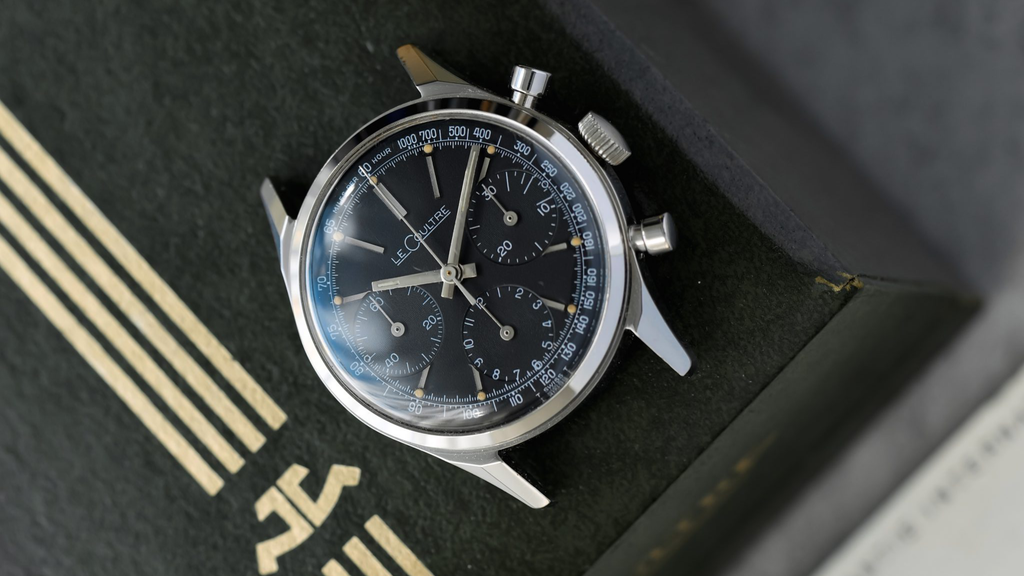 The LeCoultre E335 with black dial... a perfect hybrid between the Heuer Carrera and the Movado M95. The sporty elegant style of an archetypical 1960s chronograph. Photo Courtesy of Hairspring Watches and Hidden Gems.
The LeCoultre E335 with black dial... a perfect hybrid between the Heuer Carrera and the Movado M95. The sporty elegant style of an archetypical 1960s chronograph. Photo Courtesy of Hairspring Watches and Hidden Gems.
The 60s Racing Style. One of the most sought after chronograph designs of our time are the classic racing and sports chronographs of the 1960s. Think Daytona, Carrera, Speedmaster... and the list goes on. Looking into the LeCoultre offerings two examples stick out that perfectly match this category - the E335(/2644 black) and the E355. However, the LeCoultre designs are far from redundant to the big names of the era... I think about them as the love child between a Heuer Carrera and a Movado M95 Borgel.
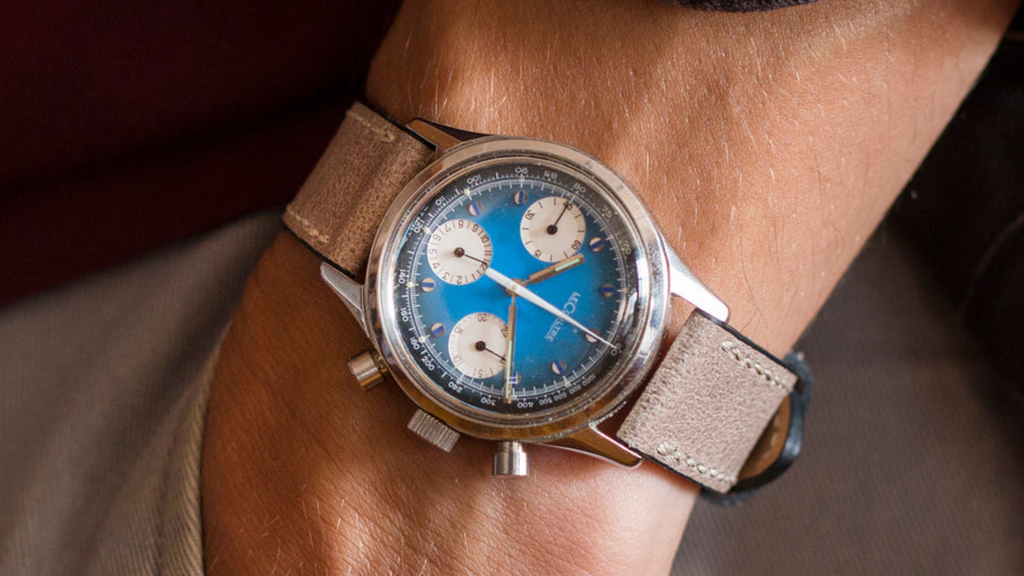 My taste is a lot more simplistic than some of these 1970s chronos would allow but such a E2644 in black and blue is something I could probably pull off. Photo Courtesy of Hodinkee.
My taste is a lot more simplistic than some of these 1970s chronos would allow but such a E2644 in black and blue is something I could probably pull off. Photo Courtesy of Hodinkee.
The eye-catcher. The other two categories have been a bit too understated? You want to make a statement, have everybody notice your wrist? When asked how many colors you want, you answer "Yes!"? Yeah, you can get a LeCoultre for that as well. And you can even choose between flashy dial, flashy case and noticeable bezel... The E2644 fume for example is the perfect hybrid between sporty case designs and unique dial adaptations.
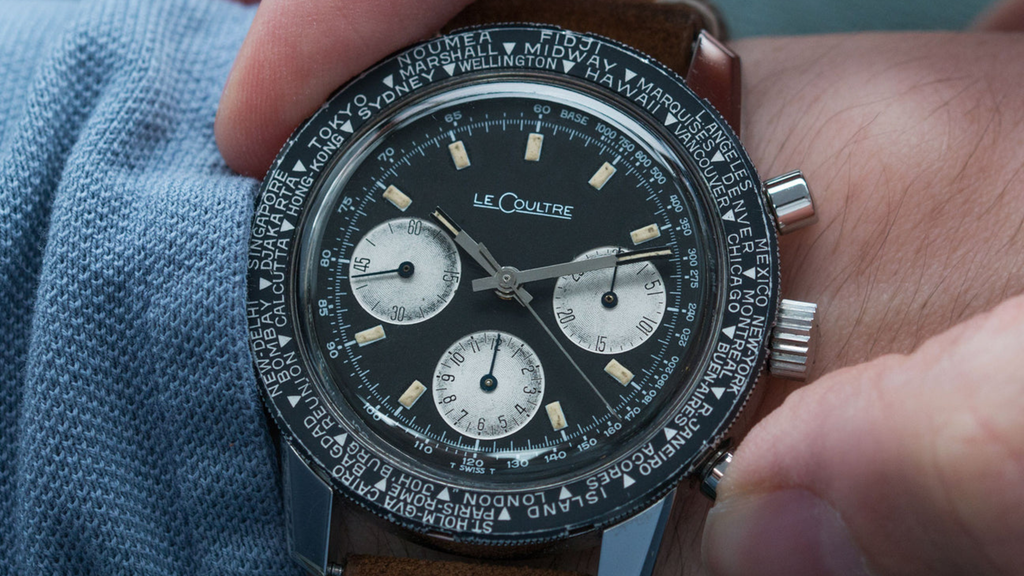 I'll argue that there's a LeCoultre chronograph for every taste. You like it sporty and want a dive chronograph with world-timer bezel? LeCoultre got you covered with the ref. E2643 DeepSea "Shark". Photo Courtesy of A Collected Man.
I'll argue that there's a LeCoultre chronograph for every taste. You like it sporty and want a dive chronograph with world-timer bezel? LeCoultre got you covered with the ref. E2643 DeepSea "Shark". Photo Courtesy of A Collected Man.
However, coming back to the collectibility aspect... We need to address the elephant in the room: Uncertainty scares buyers. Mystery makes a great story but not the best business... As long as we know so little about these pieces the decision to get one will always be relatively tough.
Dang, it becomes borderline nerve rattling when even some of the contemporary evidence is flawed... Here we got a catalogue excerpt from 1968 where two metal-to-watch descriptions are plainly wrong. There's an E355 that's described as "Solid 18k Gold" (which it isn't) and a Funky Gold as "Stainless Steel" (which also is not documented elsewhere).
- "This is a typical composition error from whoever was in charge of putting the catalog pictures and overlay text together." - Florian @fldx_clavi.
 1968 LeCoultre catalogue excerpt displaying three not exactly specified chronograph watches. To make scholarship worse, the person putting the text overlay together confused the "Stainless Steel" and "Solid 18k Gold" examples (according to Clavi @fldx_clavi) - thus you won't find any documented pieces in this particular arrangements. Photo Courtesy of Clavi @fldx_clavi & Charlie Dunne (@strictlyvintagewatches) of WindVintage.
1968 LeCoultre catalogue excerpt displaying three not exactly specified chronograph watches. To make scholarship worse, the person putting the text overlay together confused the "Stainless Steel" and "Solid 18k Gold" examples (according to Clavi @fldx_clavi) - thus you won't find any documented pieces in this particular arrangements. Photo Courtesy of Clavi @fldx_clavi & Charlie Dunne (@strictlyvintagewatches) of WindVintage.
And we can't even estimate the exact age of these pieces as well. If we look at case numbers there seems to be the 211.xxx serials from 1958 and 311.xxx serials ten years later in 1968. But that's something we can only learn if we find examples with the original sales papers.
Similarly, we can only start to estimate production runs of certains models based on catalogues, ads and the likes. Add that most of these chronograph pieces - especially before 1970 - are rarely hitting the market finding a comprehensible price point for both buyer and seller becomes immensely difficult.
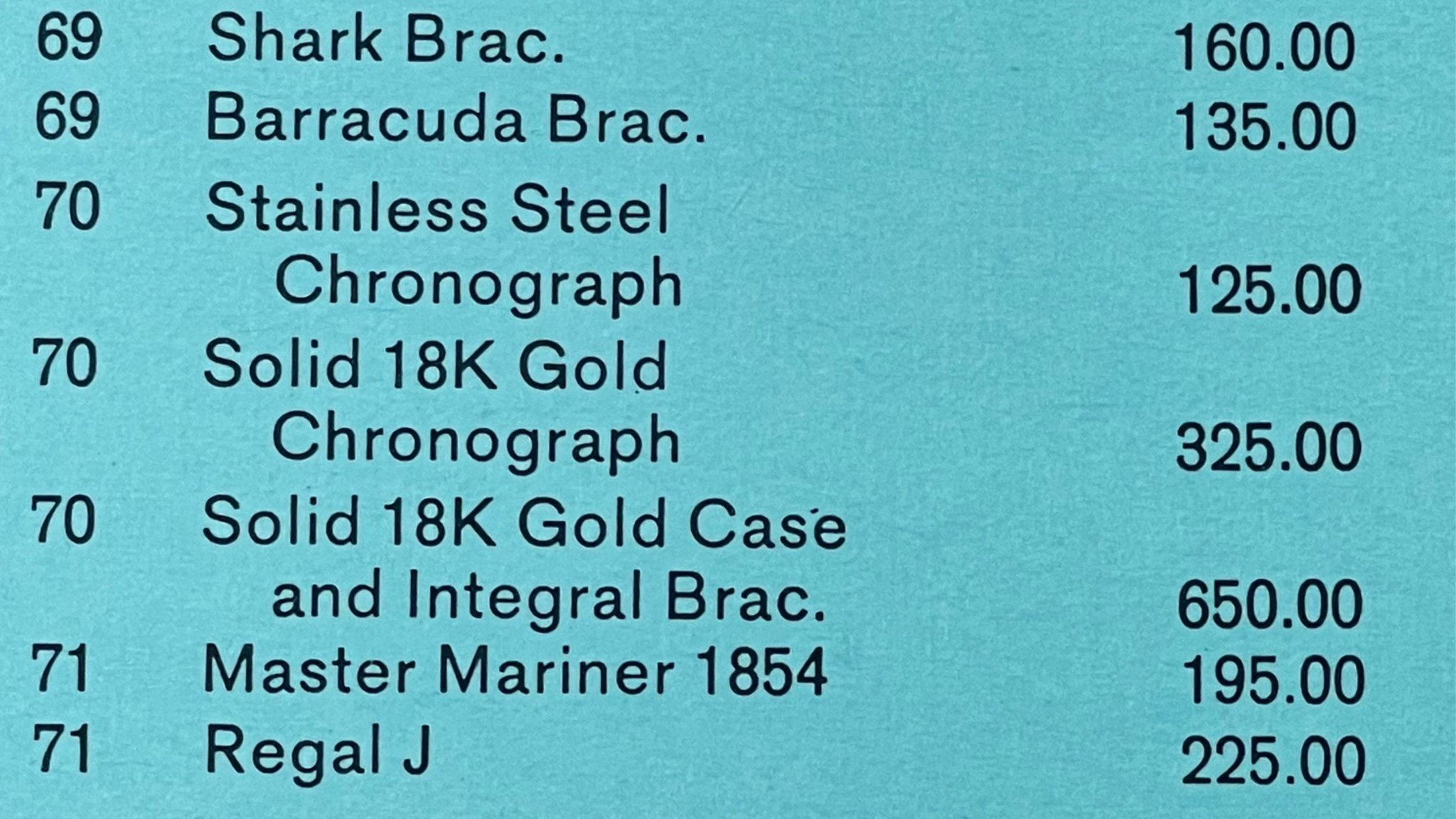 1968 pricelist for several LeCoultre watches including some chronograph pieces. In comparison a stainless steel Rolex Daytona in the early 70s would cost you about 386$. A Heuer Carrera 2447 upon introduction in 1963 came in at 90$. And unfortunately we still don't see a classic reference number system to make more sense of these pieces. Photo Courtesy of Clavi @fldx_clavi.
1968 pricelist for several LeCoultre watches including some chronograph pieces. In comparison a stainless steel Rolex Daytona in the early 70s would cost you about 386$. A Heuer Carrera 2447 upon introduction in 1963 came in at 90$. And unfortunately we still don't see a classic reference number system to make more sense of these pieces. Photo Courtesy of Clavi @fldx_clavi.
With all the uncertainty and mystery it's safe to say LeCoultre chronographs are special! Technologically they are on par with the all time greats from the same era, encased in marvelous steel or gold frames... the designs are original and have character. Yet, they are still underrated. If we can fill some of the holes in their history these pieces can finally get the appreciation and recognition they deserve. So what I want to say is: Make U.S. LeCoultre Chronographs Great Again!.
This guide wouldn't have been possible without the help from the JLC community! This is very much a group effort I was lucky enough to write down. I'd like to thank in particular Clavi (@fldx_clavi), Charlie Dunne (@StrictlyVintageWatches), and Herman (@hurmen) for their invaluable input to this project! Further, Sebastian from @Watchurbia contributed with his insights.
x There have been chronographs and more complicated pocket watches during the early 20th Century - approximately a couple dozen to 100 pieces manufactured in total. Also Jaeger in collaboration with Cartier - European Watch & Clock Co. - produced a couple chronograph watches between the 1920s and 1930s ([example]).
* It's not exactly clear how common chronographs from the three markets have been. Nevertheless, taking a snapshot from the vintage market right now you'll have a hard time finding full Jaeger-LeCoultre signed chronographs from before 1980.
** I will try and address the Jaeger signed chronographs another time as well.
*** In contrast to the UG examples, which were made from "Enversteel".
References
[1] The Jaeger-LeCoultre Reverso Chronographe Retrograde, The First In-House Integrated Chronograph Post-Quartz Crisis; Suhrud, Monochrome Watches [Link]
[2] Jaeger-LeCoultre & the U.S. Market; Marcus Siems, Goldammer Vintage Watches [Link]
[3] Jaeger-LeCoultre and the U.S. market, part 1; The Blomman Watch Report [Link]
[4] Swiss Poincons de Maitre; David Boettcher, Vintage Watchstraps [Link]
[5] The Reymond Brothers & Their Chronographs - A Guide to the Valjoux 23/72; Marcus Siems, Goldammer Vintage Watches [Link]
[6] LeCoultre chrono. legit or not?; OmegaForums [Link]
[7] All You Need To Know About Early Vacheron Constantin Chronographs (1916-70) - An Introduction; Marcus Siems, Goldammer Vintage Watches [Link]
[8] LeCoultre Chronograph Reference 224115; Charlie Dunne, Strictly Vintage Watches [Link]
All rights on text and graphics reserved to the Author.













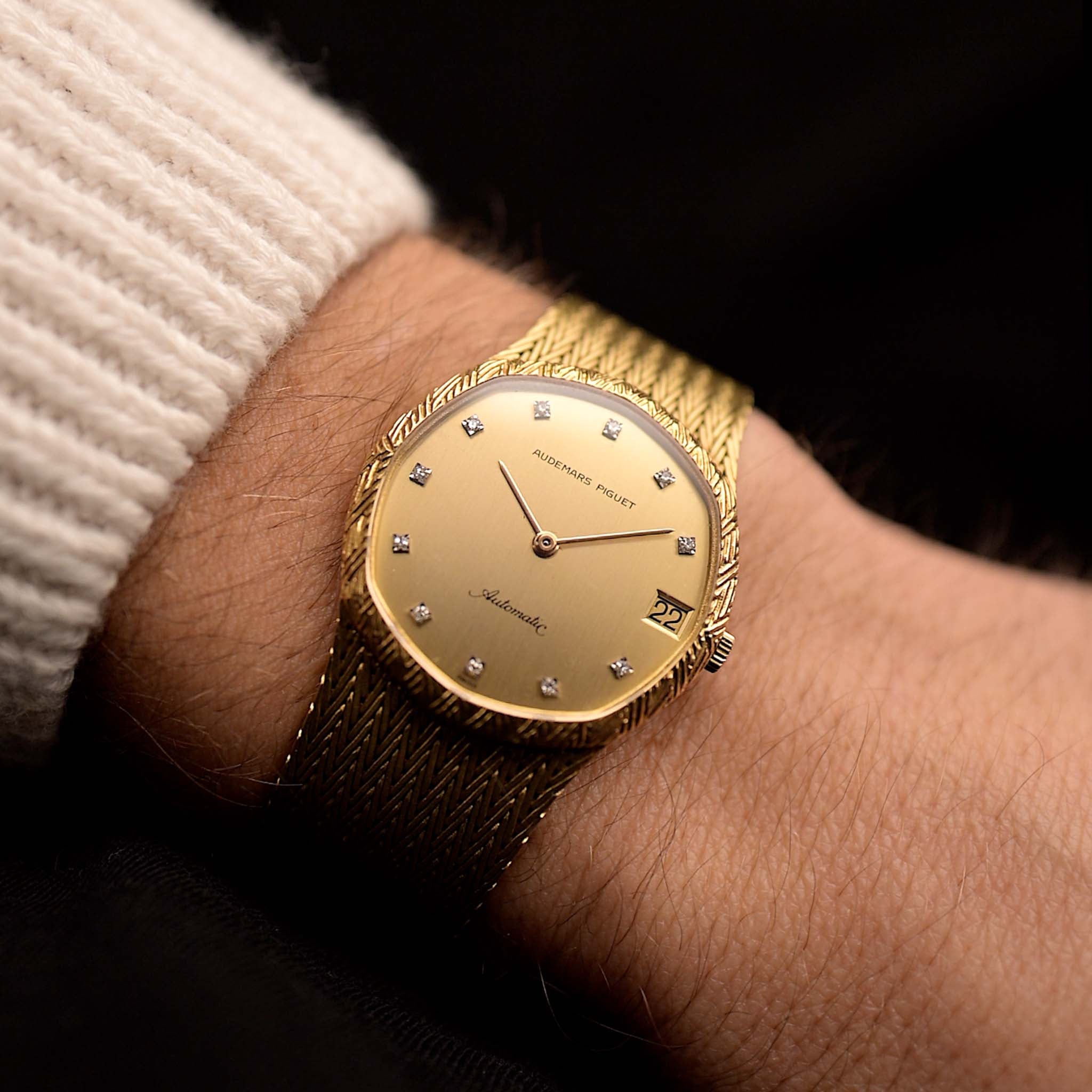














1 comment
I have a 1950s lecoultre valjoux 72 chronograph movement I would like to sale. It’s I’m good condition and runs. Do you buy or could you refer someone who does. Thank you
Leave a comment